What are Y’all and How Did You Get Here?
If you’re wondering how the monks came to West Virginia and what we’re up to nowadays, this article answers those questions and a lot more that you may want to ask when you run into one of us somewhere around town. The short version: Moe Sill invited us.
Let me tell you about the man who made this all possible “Way Out Wayne.”
The Front Door
Moe and I were driving up the monastery’s old gravel road right after the burial service for Moe’s neighbor, Lois “Toots” Adkins. We had just buried Moe’s wife, Nadya, a few days earlier at the monastery cemetery and were coming from the Adkins family cemetery to visit Nadya’s grave on the other side of the hollow. Nadya and Toots were neighbors for 25 years and passed away within four days of one another.
Moe began to explain to me some of the wisdom he had gleaned during his time of agricultural and missionary service in India, “You know, I wouldn’t tell this to all my family…but you’re old enough to understand this now.” I was 23 years old when I first came to West Virginia and met Moe, and now I was a monk and over 40—he was 93. He continued, “There’s this term that the Indians use, ‘Ashram.’ It means ‘retreat’ (like a hermitage in the woods). But it also has another meaning, they use it to describe the stages of life. It’s not from our tradition, but we can understand it as an explanation of the time periods of our life. You understand what I’m saying…” he said waving his hands affirmatively. And he continued, “Ashram I is our birth, growth, and education: acquiring experience in the family and training in life. Ashram II is the time of cultivating our own family life. Ashram III is when a man supports his community. And Ashram IV is when he prepares for death and the next life.” As we bumped along the old road to the cemetery, he reminisced, “I had painted Ashram III on the front door of the log chapel up here because I saw this as my place of interacting with the community.”
Answer to an Old Riddle
I was so surprised that I could have slammed on the brakes at that moment because he answered a twenty-year-old riddle I had completely forgotten about. “I was wondering why that was there!” I said with astonishment. “I thought someone had painted graffiti on it.” When I first saw that strange painting on the door, I was a little creeped out not knowing the origin of such a cryptic inscription on an old log cabin just a few miles away from the middle of nowhere. But now, after living about half of my life in Moe and Nadya’s holler, which has now become the Hermitage of the Holy Cross, I’ve come to deeply understand Moe’s farsighted intention when he inscribed Ashram III on the front door of his old chestnut cabin almost 50 years ago. It became the place of his greatest contribution to the local community, while he himself was preparing for the next life.
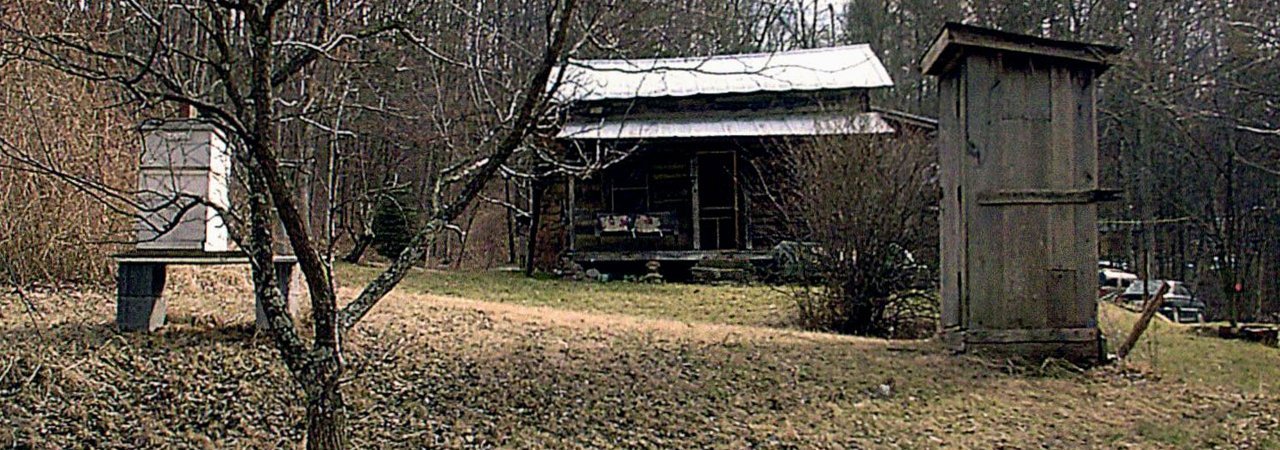
Moe and Nadya Sill’s chestnut log cabin chapel dedicated to the Entry of the Theotokos into the Temple, the first Orthodox Christian Chapel in Wayne, West Virginia
A West Virginian Founds a Russian Orthodox Chapel
When he acquired the old Joe Bradshaw cabin and farm in 1975, he turned the original homesteader’s cabin into the first Orthodox Christian chapel this side of Twelve Pole Creek (and probably the other side, too). He founded what would become the first officially recognized Russian Orthodox chapel in Wayne County, West Virginia. As a native West Virginian, his connection to the Russian Orthodox Church may seem unusual, but it was completely natural and personal for him since he had married the daughter of Russian émigrés.
Nadya: A Silent and Powerful Witness
His wife, Nadezhda Mikhailovna Danilchik, was the daughter of a Russian Orthodox priest from Seattle. Her family had fled the totalitarian atheists that took over the largest Christian country in the history of the world—what used to be known as “Holy” Russia until 1917. When the militant Marxist created the USSR and forced the Christian people of Russia into submission, thousands fled to the farthest reaches of the earth in order to maintain their Christian faith. Nadya’s parents ended up in Canada where she was born, and subsequently the family moved to the USA where she was educated. Professionally, she worked in US Embassies in Egypt, Lebanon, and Pakistan, then for the Peace Corps in Washington, DC, then as an Equal Opportunity Officer for the Army Corps of Engineers in Huntington, West Virginia. She maintained her family’s faith everywhere she lived, even in rural Appalachia. She’s the one who introduced Moe to the most ancient form of Christianity, the Orthodox Christian Faith.
Dr. Sill’s Early Career
Similar to Nadya, Moe had an adventurous career in his early life. Born in Follansbee, West Virginia in 1925, he grew up as the son of the first WVU Extension Agent for Parkersburg. Moe was so enamored by his father’s agricultural consulting work that by the time he was 12 years old he knew he wanted to be an agricultural missionary. He studied Rural Social Economics and Naval Science at the University of Virginia and received a doctorate in Rural Sociology from Penn State. He served in the navy where he learned to fly airplanes. He trained the first Peace Corps in India and was the first country officer for the Peace Corps in Pakistan. He was instrumental in setting up the nation-wide Agricultural Service within India and also served there as a Methodist missionary. It was in India during the 1950s that he began raising his family with his first wife Barbara “Bardee” Struck with whom he had his five children.
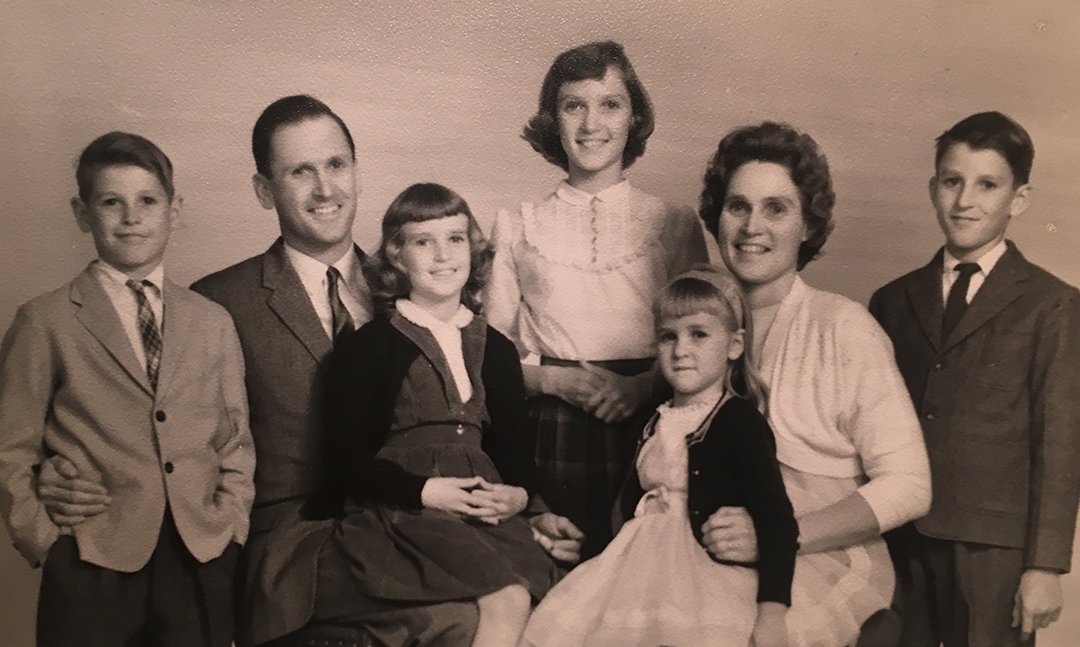
Moe & Bardee Sill with their children
Return to the USA and Teaching at Marshall University
After returning to the US, Moe worked in rural Appalachia, especially Kentucky, in the 1960s during the on the US “War on Poverty.” In the 70s Moe and Nadya married, and he became a professor in the Anthropology and Sociology Department of Marshall University in Huntington, WV. One of his students from those years remembers:
Dr. Sill was an outstanding professor with a keen sense of interest in ideas and people. He shaped a lot of my values both through his stories from Peace Corps and his encouragement (class requirement) that we get involved in our communities.
Dr. Susan Weaver, Department of Education, University of the Cumberlands. Williamsburg, Kentucky
Way Out Wayne
In 1975, Moe and Nadya purchased the old Bradshaw farmstead way out Wayne County, near the head of Millers Fork Creek. A hundred years prior, the region was a booming agricultural area hailed locally as the “Bean Capitol of the World.” And Mt. Union Ridge upon which the Bradshaw farm bordered was famous for its apple production. If you look at the old USDA fly-over photographs (last century’s version of Google Maps), as late as the 1950s you can still see lots of orchards and other fields being used for agricultural purposes. Even the old-timers around here recall that you could stand on top of any hill and look down and see someone working with a mule. They explain that horses started too fast and were hard on equipment, while mules eased into the pull. Tractors just weren’t around and were too dangerous on the steep hillsides anyway. But local families farmed these steep lands nonetheless because our ancestors settled here during the 1700s and have been here ever since. The old-timers also say, “We farmed because if you didn’t, you’d starve.”
Rural Social Economics: Why Wayne is “Way Out” Wayne
By the 1960s, however, subsistence farming had seriously declined in our area. Many farms had made tobacco their cash crop instead of beans—or at least in rotation with beans. The logging industry and farmers had cut down much of the original forest generations ago, while the American Chestnut blight wiped out about one quarter of our Appalachian forests by the 1950s. The blight deprived our mountain families of income and resources that our most versatile and valuable tree provided. Tractors did finally make their way into our area, which motivated farmers to decrease their farming activity on the hillsides in preference for more accessible plots. One old farmer recalled, “The government started paying farmers not to farm [the hillsides]. Then everything grew [back] up into forest.” All these factors were the death knell for a rich network of agriculture in this region, but the biggest blow to our immediate neighborhood came in the 1970s when the Beech Fork Lake project displaced hundreds of people, many important farms, and cut off the main thoroughfare between the markets in Huntington and the farmlands in the deeper parts of Wayne County. The lake project saved families and businesses downstream from flooding, but the agricultural network never survived.
Settling a Land and Un-settling It
The old way of life here was a hard one. But it was softened because the community of families and neighbors faced the difficulties of rural life together. Now, in the aftermath of the agricultural demise, our region is becoming un-settled. Whereas our ancestors moved to the region, cultivated the land, and combined families and assets through marriage creating productive farm estates, now the land is not used to support the families. Hence, the land itself is becoming wild, uncultivated, and un-settled again. Since the agricultural network disappeared, the farmlands have been inherited by multiple heirs and sub-divided. Many owners would want to sell their portion of the inheritance if there were any buyers for their inaccessible hollow far away from good roads and utilities. A few descendants might remain, living in a small home or two, or a trailer down by the creek in the lowest, least productive part of the land near the road—what would have been the old hay-bottoms. The contemporary habit of people growing up and moving away for school and work has also set a pattern for the continual fragmentation of local families and their assets.
Moe’s Methods
Moe Sill has started a trend in the other direction. He was an international mastermind when it came to rural sociology and economics. But the amazing thing was that his expertise and farsightedness came mostly from his heart and proceeded naturally from his own upbringing and extremely sociable personality. Moe summed up his approach to rural sociology with two concepts: the perceived need method and the scientific method. On a personal level, this meant that Moe took an interest in the people he was with and “figured out” (scientific method) how to help them accomplish the things most important to them (their perceived need).
He simply loved people and figured out what was necessary to bring them together to face the difficulties of life and find meaning—true meaning, not sentimentality. And although he referred to himself as an “old hillbilly,” he had a farsighted dream to reintroduce his own Appalachian folk to their own rich historical roots.
Everyone in Wayne Believes in Jesus…
Moe knew that Appalachian people are a Christian people. Even our UPS driver, one of our town’s former high-school sports heroes, said with his typical joviality, “Everyone in Wayne County believes in Jesus. Even if you go into a bar…if you say something bad about Jesus, you’ll get punched in the face!” Growing up in West Virginia, Moe had a deep Christian conviction from childhood, but when he married Nadya he dug even deeper and learned the original roots of his Faith and became an Orthodox Christian. (If you’re not familiar with Orthodox Christianity, it’s the same thing you would find if you were to visit Bethlehem or Jerusalem—the Christians that have lived there from the time of Christ are Orthodox Christians.) For his own sake and for the people of Wayne, he transformed the old Bradshaw cabin into a chapel and began to conduct small services there according to the ancient Christian rites. Even though they didn’t have a priest, Moe and Nadya prayed there faithfully for 25 years.
Faithful Companions
Priests and monks from Holy Trinity Russian Orthodox Monastery in Jordanville, New York would visit the Sills from time to time, serve the Divine Liturgy, and help with farm work. Moe invited people, tried to start other missions or local Orthodox gatherings, but only one other West Virginian joined him in his religious endeavor: an old, black mountain man that was baptized with the name of Cyril. Once Cyril’s African-American relatives tried to change his religious convictions asking him, “Hey, Charles. Why aren’t you Baptist like the rest of us?” With his classic hillbilly accent, he offered his defense of the ancient Orthodox Faith, “I been with them people for a long time.” That was it. Moe had connected with Cyril in a deep personal way. Moe was not an ideological missionary. Everything was personal and relationship-oriented for him. Through all those years at the farmstead in Wayne, it turned out that Moe’s most faithful companions in his endeavor were his wife Nadya and friend Cyril: a Russian and a black man. He was certainly a man way ahead of his times—and ours!
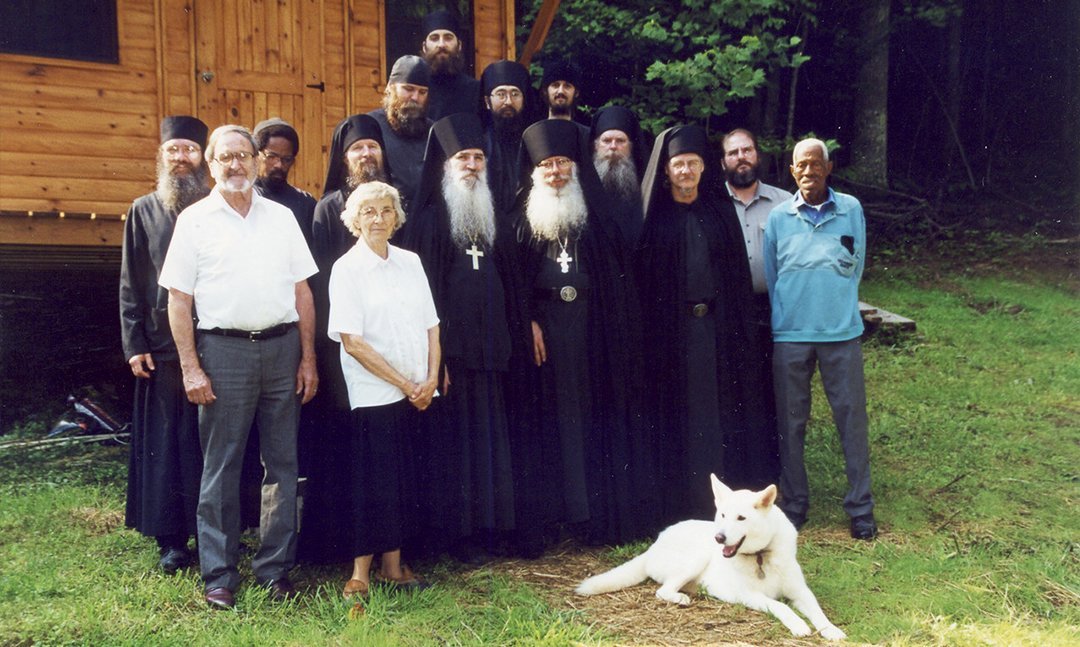
Holy Cross Monastery Brotherhood with Moe, Nadya, and Cyril “Old Man Charles” 2000
Passing the Baton
Moe continued teaching at Marshall until 1990. By the year 2000, he and Nadya were becoming too old to manage the upkeep of their remote property. They had tried for decades to get some kind of youth camp or Orthodox Christian community started here, but to no avail. However, their 25 years of faithfully conducting reader services without a priest finally bore fruit when they offered our brotherhood to take over their land and chapel. Moe wanted to move near his grandkids and leave us to continue and amplify his work. Because they had maintained their faith and home prayer services, they had spiritually cultivated and prepared the land to receive a monastery that has grown to into a significant spiritual, social, and economic anchor for our region.
Monks Move In
When our small brotherhood moved here we inherited Moe and Nadya’s home, log cabin, a handful of pole-barns, about 160 acres of forested hillsides, and his beehives. We immediately set to work in order to convert the property into a fully-functioning monastery; and we’ve been growing, working, and praying ever since. Over the course of twenty years, we’ve constructed (or hauled-in) many new buildings, a small church, a dining hall, dormitories, guesthouses, and workshops.
The Monastery is Like a Beehive
If you were to visit today, you’d find our hidden hollow to be like a beehive during a heavy nectar flow: the amount of activity is truly amazing, but it’s noticeably peaceful—even joyful. You’d see monks, monastery workers, and visitors working at their tasks together. Yet while there are many different tasks in the monastery, everyone knows their work. And it’s all done for the common benefit of our entire monastic community, which holds all things in common. First-time visitors often have the same type of first impression that you would expect to see on the face of a new beekeeper who looks eagerly into a beehive for the first time: it’s an encounter with a whole new world. Our visitors often say with quite amazement, “Wow. I had no idea all this was here… It’s really peaceful here.”
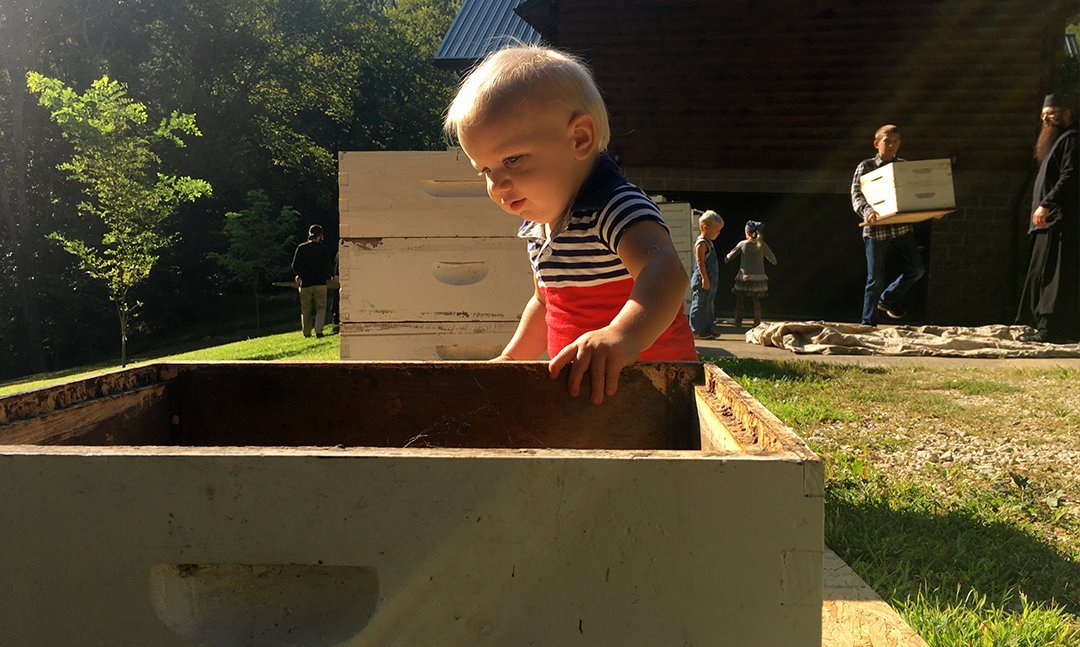
“Everyone knows their work.” Baby Gabe Parsley examines his first beehive box while the rest of his brothers and sisters work with the monks. The black locust tree in the background is part of a planting that Moe and the kids helped with the previous year.
Contagious Serenity Attracts Families
Many who visit and feel heartfelt peace here want to continue to experience it. Some return in order to join the monastic brotherhood. Others have moved near the monastery with their families to be able to attend services and participate in the work of the brotherhood. After only a few years of our move from St. Louis to West Virginia, it was necessary to found a parish church in the town of Wayne for all of the families that gathered to partake of the Orthodox ethos here. Moe was glad to see that local families were discovering their ancient Orthodox roots and other families were moving into the area bringing with them their sincere spiritual aspirations along with their skills and industry. Over the past twenty years parishioners have filled vital roles in the broader community, started businesses, and operated a food pantry to help our local families and friends.
Prayer and Work: Monastic Industry
Even though our main work is continual prayer for the peace and salvation of the world and ourselves, we have started a handful of industries to support our life of prayer. We make Athonite-style incense, raise dairy goats, make handmade soaps and scented candles, bake bread and pastries, operate a beeswax candle factory (we make about 22,000 lbs. per year), sell Orthodox icons, books, and gifts—and last but not least, we continue to operate the apiary that Moe gave us. We make honey, produce queens and nucs, package and sell honey from local family-owned apiaries, and we are now beginning a beehive frame assembling business specifically for a neighbor who needs a source of income.
Moe’s Last Agricultural Endeavors
During the last year of Moe’s life, he began to visit the monastery more often, and he actively participated in significant agricultural projects at the monastery. He attended the ceremonial planting of two American Chestnuts at the monastery conducted by the American Chestnut Foundation—part of an initiative to reestablish this valuable tree in Appalachia and educate monastery visitors about the project. Moe also helped fund the planting of black locust trees to help feed our bees and control erosion. We also worked out a plan with him to set up beehives at his retirement home. But since they already had beehives, we used the intended hives to help get a local young man, Alexey Campbell, started with beekeeping. Moe said, “I am much inspired by the plans you are making…
Let’s see what God allows.
Moe Sill’s favorite saying,
from his spiritual father, Hieromonk Ioannicius
Turning Point
It is certainly rare that a man sees his biggest dreams come true in his own lifetime, but Moe was a rare man. He was thrilled to see all of the social and economic activity naturally blossom in tandem with the spiritual life of the monks here in Wayne, West Virginia. But the day of Toot’s burial and his visit to his wife’s grave was a turning point for Moe. In fact, it was his last turning point toward the last stage of his life. He saw his own monks and neighbors sharing life and death together. He saw us singing and sharing as one large family; it had all become so natural. On the way to his wife’s grave that day, he finished his analogy about the cycles of life saying, “If it still says Ashram III…you can change it to Ashram IV.” He was finally finished with his work in this life: he saw the Orthodox community as a natural part of his home State. He had passed the baton to the next generation and was telling me he’s ready for the next life.
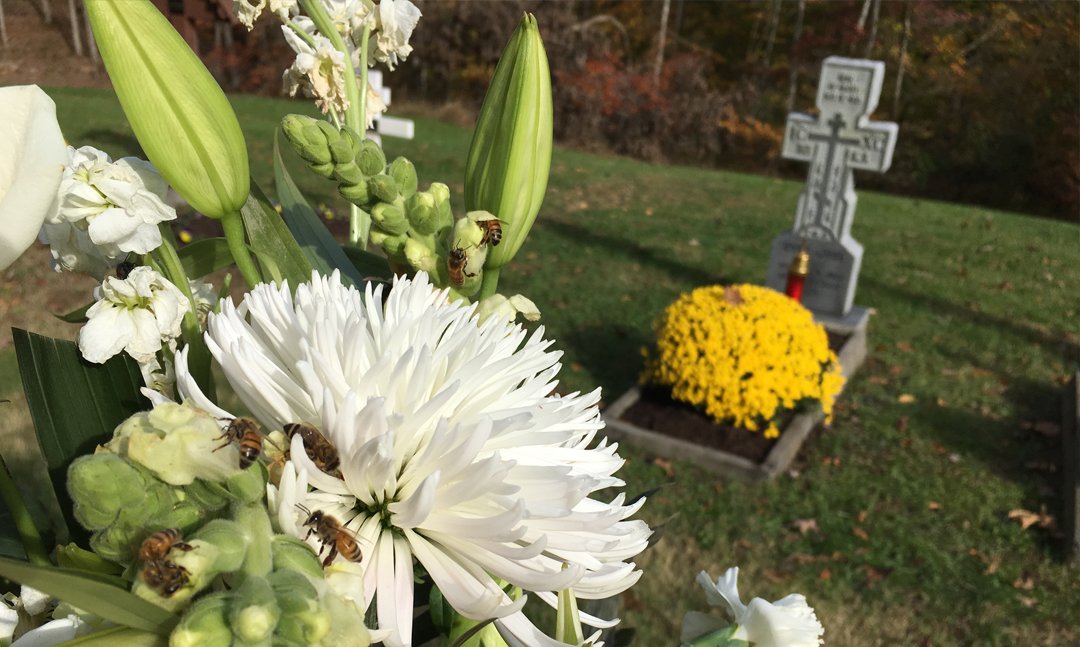
Monastery honey bees working the flowers on Nadya’s grave, November 2018. This was just moments after Moe saying he is preparing for death.
How Did She Know?
He died at the age of 94 within a year of stating his intended departure from this life. He had lived through and seen so much and had impacted the lives of so many. His funeral was filled with endless heartfelt eulogies. One in particular stood out to me that day. His daughter (who had spent her youth in India) mentioned something about her dad and his ideas about serving the community and his “Ashram III.” I was puzzled. Moe had acted like I shouldn’t say anything about the topic to his family. How did she know? But of course she knew! Everyone who came to his homestead knew. After all, he had painted it on the front door of his log cabin!
But now his log cabin, his community, and his love for it are ours.
Memory Eternal!
May God grant eternal rest to the man who made all of this possible,
Dr. Maurice Lucien Sill. 4 June 1925–6 June 2019
See you out Wayne, Monk Serge.
See What's New Way Out Wayne
New Monastery Church Project & New Russian Bells
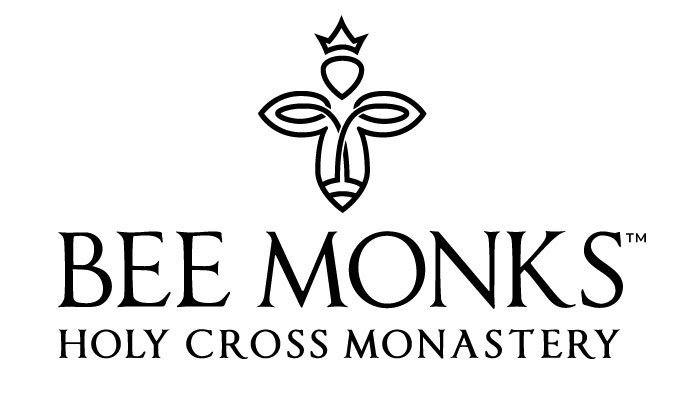
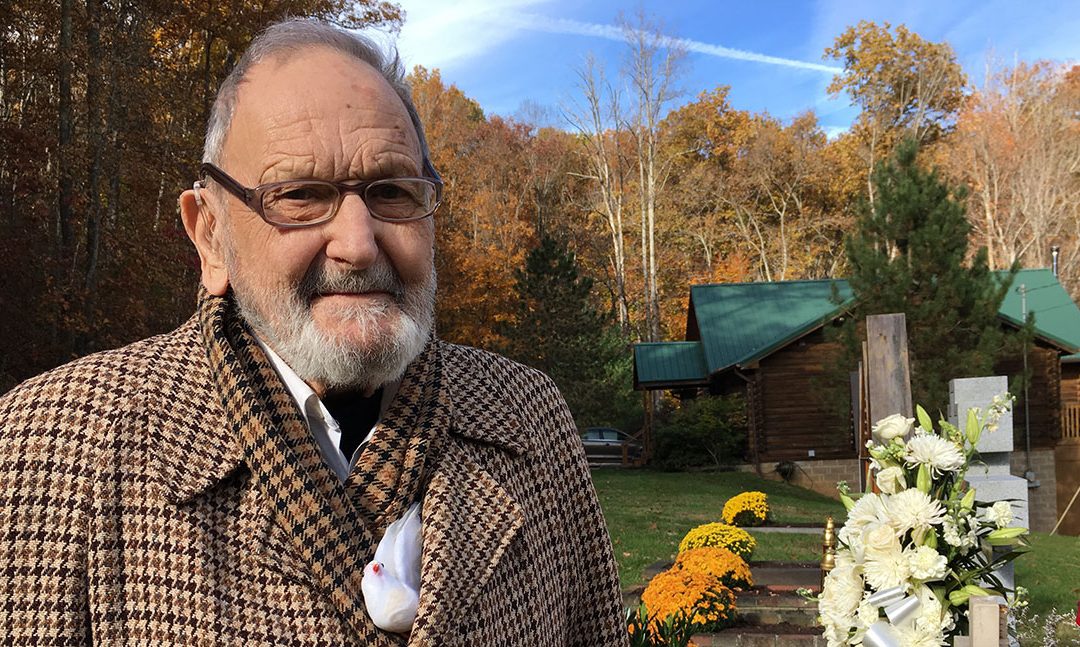
What a wonderful history and beautiful writing by monk serge. Although we’re baptists you all have sure been good to my little daddy (Herb Adkins) and his wife Toots. Thankful to have friends like you.
Thank you, Tina. We are thankful to have y’all as friends, too.
I am so thankful for this lovely account of dad’s life’s purpose. It captures his heart very well. Thank you Father Sergius for your friendship with dad and the desire to share his heart to build community with others. Elaine Pearson
Thanks be to God. May He remember your dad in His Kingdom! FSG
Great article Serge. I remember as a kid riding our bikes out the “Joe Ridge” road that linked Ashram with Mount Union Ridge Road where I lived. We always thought it was a hippie commune. There was a sign on Joe Ridge that pointed the way to Ashram, but we never went. We just didn’t know. Until one day I was at my Uncle Calvary Stephenson’s and I met Moe and Nadya for the first time. I was still a young boy but I remember the stories Moe shared with us. My Uncle Cal helped Moe with developing his farming skills and Moe was the only person I knew who drove a Mercedes Benz. Later when I attended Marshall would see Moe around campus’s and he was always engaged in conversation with someone or a group of students. After living within just a couple of miles of Ashram most of my life (my parents still live there) I finally paid my first visit to the Monestary where I along with my dad met Serge to ask the Monks to do the graveside service for my Uncle Delbert Stephenson. Of course they agreed as they had become beekeeper friends with my uncle who lived on the hill on other side of Miller’s Fork Creek. It was then that Serge explained to me that they are regular people, same as us. They just dress different and of course devote their life to serving God. So now, every time I see one of the Monks at Walmart, the airport, wherever, I always make a point to say hi and thank them for being a part of Out Wayne. This article brought it all full circle for me. Think I will take a bike ride on the Joe Ridge next summer and this time, I am definitely stopping by.
Sid,
Glory to God! We’re glad you like the article. And we look forward to seeing you again up here at what is now called “Holy Cross Monastery.”
There was a sign on the ridge road, too?! Yeah, “Ashram” does give a bit of the wrong impression, but at least now, people can read this article understand what it meant to Moe and why. He was deeply Christian and only used that term as an allegory.
It was a great honor for us to be with your family for Uncle Delbert’s funeral.
I remember the Mercedes Benz graveyard right outside the old gate with six-foot-tall weeds growing through them. Moe was really efficient and liked to use resources wisely. He probably got a Mercedes because their diesel engines are supposed to last forever. And if I had to guess, Moe probably bought two or three salvaged MB and made one good one out of them (what good West Virginian doesn’t know how to do that)!
Moe always tried to look for ways to invest rather than spend. He invested everywhere he could, but his favorite thing in life seemed to be investing in the person right in front of him. Everyone felt that…
See you next time, Sid. God be with you,
Deacon Serge
As a former store mgr at the Wayne Walmart I would see the monks shopping at my store, ,sometimes daily….I was always impressed by the peaceful aura around them. I would smile and say hello, but I’m sorry to say, I never had a real conversation with any of them. After reading this informative article I wish that I had! Everyone knew about the monks “ Out Wayne” but I’m sure few knew the history of its beginning and eventual monastery. Great, informative article! Thank you!
Thank you, Patricia.
Please feel free to introduce yourself next time you see one of us around town, or come on out to the monastery sometime. If you’d like to visit, just give us a ring or send us a message to let us know in advance.
We look forward to meeting you. God bless,
Your Out Wayne Monks
I loved every word of your article. It reminded me of how Dad used to love tracing the rich cultural roots of people in the Appalachian hills by tracing where some of their unique words and expressions came from. One of his professor buddies and he would talk on and on about things like how some expressions in the far flung hollows were truer to very old language than what we call normal in “educated” circles.
Just in general, Father Sergius, it blesses my heart to see how you studied and valued my Dad and became such a dear friend over the years. Your writing filled an empty place in my heart this evening. My Dad and step Mom [Nadya] prayed for years that we kids would get “saved” and recognize their faith as right. Finally he started saying that the matter did not burden him so deeply as he became older.
I received a seekers manual of orthodox faith as a gift recently from Dad’s friend Wayne F., I was just about to spend some time in it when l found your article. From heaven, Dad will see some of his prayers answered. I like the non-manipulative way that people of your faith allow people to seek and grow at a slow and private and quiet pace. God bless you people for that godly attribute.
Have a good evening. I will now celebrate New Year’s Eve reading that book and remembering Dad. He lay down his life for my son. I love him now, more than l have ever loved him while he was alive.
Thank you for your thoughts, Marilyn. God be with you and your family.
A beautiful tribute to two beautiful people. Memory Eternal to Maurice and Nadiya!
Fr. Raphael, bless!
Glory to God. May God remember them in His Kingdom.
How wonderful to read this. I am one of Moe and Nadya’s many children out in the world. They were instrumental in forming St. George Russian Orthodox church in Cincinnati, Ohio. Moe and Nadya stayed in my home many times over the years. So much love for them. They knew I had prayed for Moe’s children daily for many years and in gratitude gifted me with an icon of Mary Magdalene. I loved them. Very much.
Thank you, Magdalena.
Thank you for this article.
Heather,
Thank you for reading about our dear Moe.
Glory to God!
This is a wonderful story and a beautiful tribute to the life and work of a faithful, God loving man.
I met Moe and lovely Nadya over a weekend when I visited the monastery and town church, in October, 2003. I had never met two people more genuine to the spirit of Christ’s injunction in Matthew: I was a stranger and you welcomed me. Almost twenty years later, I remember them more than many people I worked with on a daily basis for years, because of that kindness. When I left there, I adopted a VERY small stray kitten from the monastery that I named Wayne so I would never forget that small town that had such an impact on me. He died in September 2016.
Remarkably, I ran into Moe & Nadya at a small Greek Orthodox Church in Winter Haven, FL about 5 or 6 years ago, must have been shortly before Nadya passed away, and I was blown away that they remembered me. Me! I assure you, it says so much more about them, than it does about me.
I am very sad to hear that they are not longer with us but my sadness is of course, for myself. I have the time now to get to know this man better. Thank you for making that knowledge available. I am sorry I did not get to learn it first hand.